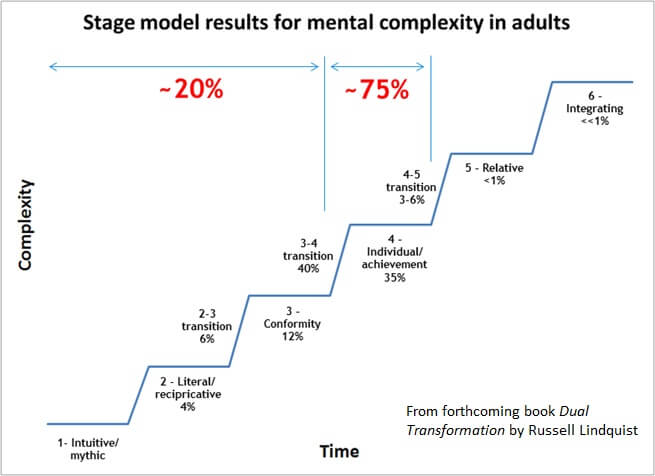
Understanding the Integral Coaching lens of levels helps us understand employee engagement and how to relate to others. Although levels of employee engagement here is in terms of mental complexity for adults, the degree of engagement is better understand by using this lens. I’m building on my previous posts looking at the article by Shih in relation to modeling employee engagement more fully. Shih’s treatment of the gap in values and priorities centers strongly on a particular range of Level development. Shih’s fundamental questions of do employees FEEL part of something bigger only captures those that are transitioning from Level 3-4 up to those transitioning beyond Level 4.
Let me back up a moment and make sure we’re all talking the same developmental complexity levels. The figure is how I define the developmental levels. It is taken from my forthcoming book, Dual Transformation.
Employee engagement looks different
By Shih even asking about how employees feel, this is interpreted very differently depending on where people lie along developmental complexity. It is true that his stance and essence seems to hit the bulk of educated adults, about 75% of the Western (mostly US) population. This represents a pretty rich and deep universe to explore. I’ll go for the highlights to work with Levels on the topic of differing values between individuals and a collective endeavor.
Tailored communication probably works best as a blended message to hit multiple levels at once.
Tailored communication probably works best as a blended message to hit multiple levels at once.
The first guidance I would provide is NOT to try and migrate people in this dimension. Rather, cater to the levels in how communication and power is shared will likely garner the most alignment and impact. The second guidance I would provide is for those with formal and informal power to become aware of their own Level so they can best relate to the task at hand: finding a solution to differing values and priorities amongst individuals compared to the organization.
Sharpening the message for the audience
Tailored communication probably works best as a blended message to hit multiple levels at once. Then, as communication professional advocate all the time, high frequency to get the message out there and understood. It will take quite a bit of frequency and Q&A to work with a blended message because some aspects will look contradictory so it is crucial that the management team know where they sit with the Levels and then can effectively translate the message to their own Level and perhaps even others if they are developed in regard to the Levels.
- Level 2 – Reciprocity: What Level 2s need to hear in order to take action is they will receive a specific benefit through their involvement. If there is enough trust present, they will make one or two attempts on their own before they will require reciprocative benefit for taking such faithful action. An emotional debt will accumulate quickly and usually silently with this group. The more influential members sway masses of people easily and quickly and will make increasing demands of atonement and appeasement.
- Level 3 – Group rules: Level 3 folks need to see how the rules are changing and why this will bring more order and success. This has to be pretty easy to understand with typical cause and effect closely linked in time and action. Long term plans are less likely to lend sway here unless clear effects of order, conformance and improvement are felt very early to show alignment that works to help the group and protect individual interests. The assumption here is that the rules are there for a reason so why change them? They like everyone to play by the rules to succeed. The more abstract and longer term the more enforcement of new norms will need to be public for Level 3 types to get behind it.
- Level 4 – Achievement: Level 4 types are looking for how they can benefit personally. This could be financially, how they gain power or more freedom. They typically will test boundaries publically and privately. Conveying the spirit of closing the values gap needs to be communicated so that the novel solutions and Level 4 energy is aligned with the outcome desired, not being too prescriptive of method. Early experimentation that is made acceptable and contained will help Level 4 people get on board. Rewards have to come quickly after no matter the outcome. That doesn’t mean allowing unfruitful experiments to grow but recognizing the initiative they brought to the effort is key.
- Level 5 – Relativity: For those rare instances where Levels 5s appears, be mindful of their ability to actually slow things down and expand the scope to an unproductive degree. Level 5 starts to suspend judgment, delay decisions and rework efforts as their context expands. Welcoming their questions and addressing their musings in private helps gain alignment. They frequently will question the motivation, tactics and outcomes. Being transparent here and even admitting the shortcomings of the work at hand will go a long way to bring Level 5s along in a healthy way where they honor the limits and work within the scope. They also help early on to make sure proper inclusion happens and often can translate upchain where other Levels are.
If you’re leading this type of effort, about the time you are sick of delivering the blended level message is about the time people will actually start to understand and take action. Your commitment and energy here is crucial to get past the differences in Levels in order to gain collective action in the same direction.
